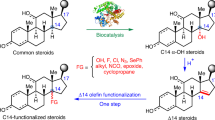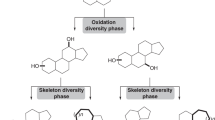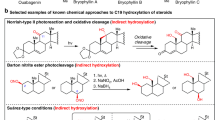Abstract
Today, more than 100 Food and Drug Administration-approved steroidal agents are prescribed daily for indications including heart failure, inflammation, pain and cancer. While triumphs in organic chemistry have enabled the establishment and sustained growth of the steroid pharmaceutical industry, the production of highly functionalized synthetic steroids of varying substitution and stereochemistry remains challenging, despite the numerous reports of elegant strategies for their de novo synthesis. Here, we describe an advance in chemical synthesis that has established an enantiospecific means to access novel steroids with unprecedented facility and flexibility through the sequential use of two powerful ring-forming reactions: a modern metallacycle-mediated annulative cross-coupling and a new acid-catalysed vinylcyclopropane rearrangement cascade. In addition to accessing synthetic steroids of either enantiomeric series, these steroidal products have been selectively functionalized within each of the four carbocyclic rings, a synthetic ent-steroid has been prepared on a multigram scale, the enantiomer of a selective oestrogen has been synthesized, and a novel ent-steroid with growth inhibitory properties in three cancer cell lines has been discovered.
This is a preview of subscription content, access via your institution
Access options
Access Nature and 54 other Nature Portfolio journals
Get Nature+, our best-value online-access subscription
$29.99 / 30 days
cancel any time
Subscribe to this journal
Receive 12 print issues and online access
$259.00 per year
only $21.58 per issue
Buy this article
- Purchase on Springer Link
- Instant access to full article PDF
Prices may be subject to local taxes which are calculated during checkout





Similar content being viewed by others
References
Windaus, A. Concerning the constitution of cholesterol and biliary acid. Z. Physiol. Chem. 213, 147–187 (1932).
Bachmann, W. E., Cole, W. & Wilds, A. L. The total synthesis of the sex hormone equilenin. J. Am. Chem. Soc. 61, 974–975 (1939).
Lednicer, D. Steroid Chemistry at a Glance (Wiley, 2011).
Pines, S. H. The Merck bile acid cortisone process: the next-to-last word. Org. Proc. Res. Dev. 8, 708–724 (2004).
Marker, R. E., Tsukamoto, T., Turner, D. L. & Sterols, C. Diosgenin. J. Am. Chem. Soc. 62, 2525–2532 (1940).
Renneberg, R. Mexico, the father of the pill and the race for cortisone. Biotechnol. J. 3, 449–451 (2008).
Hanson, J. R. Steroids: partial synthesis in medicinal chemistry. Nat. Prod. Rep. 27, 887–899 (2010).
Biellmann, J. F. Enantiomeric steroids: synthesis, physical, and biological properties. Chem. Rev. 103, 2019–2033 (2003).
Covey, D. F. ent-Steroids: novel tools for studies of signaling pathways. Steroids 74, 577–585 (2009).
Green, P. S. et al. The nonfeminizing enantiomer of 17β-estradiol exerts protective effects in neuronal cultures and a rat model of cerebral ischemia. Endocrinology 142, 400–406 (2001).
Akwa, Y., Ladurelle, N., Covey, D. F. & Baulieu, E. E. The synthetic enantiomer of pregnenolone sulfate is very active on memory in rats and mice, even more so than its physiological neurosteroid counterpart: distinct mechanisms? Proc. Natl Acad. Sci. USA 98, 14033–14037 (2001).
Petit, G. H. et al. Pregnenolone sulfate and its enantiomer differential modulation of memory in a spatial discrimination task using forebrain NMDA receptor deficient mice. Eur. Neuropsychopharmacol. 21, 211–215 (2011).
Yeung, Y.-Y., Chein, R.-J. & Corey, E. J. Conversion of Torgov's synthesis of estrone into a highly enantioselective and efficient process. J. Am. Chem. Soc. 129, 10346–10347 (2007).
Yoder, R. A. & Johnston, J. N. A case study in biomimetic total synthesis: polyolefin carbocyclizations to terpenes and sterols. Chem. Rev. 105, 4730–4756 (2005).
Zeelen, F. J. Steroid total synthesis. Nat. Prod. Rep. 11, 607–612 (1994).
Chapelon, A., Moraléda, D., Rodriguez, R., Ollivier, C. & Santelli, M. Enantioselective synthesis of steroids. Tetrahedron 63, 11511–11616 (2007).
Mackay, E. G. & Sherburn, M. S. The Diels–Alder reaction in steroid synthesis. Synthesis 47, 1–21 (2015).
Funk, R. L. & Vollhardt, K. P. C. A cobalt-catalyzed steroid synthesis. J. Am. Chem. Soc. 99, 5483–5484 (1977).
Funk, R. L. & Vollhardt, K. P. C. The cobalt way to dl-estrone. A highly regiospecific functionalization of 2,3-bis(trimethylsilyl)extratrien-17-one. J. Am. Chem. Soc. 101, 215–217 (1979).
Vollhardt, K. P. C. Cobalt-mediated steroid synthesis. Pure Appl. Chem. 57, 1819–1826 (1985).
Kaplan, W., Khatri, H. R. & Nagorny, P. Concise enantioselective total synthesis of cardiotonic steroids 19-hydroxysarmentogenin and trewianin aglycone. J. Am. Chem. Soc. 138, 7194–7198 (2016).
Nising, C. F. & Bräse, S. Highlights in steroid chemistry: total synthesis versus semisynthesis. Angew. Chem. Int. Ed. 47, 9389–9391 (2008).
Wender, P. A. et al. Function-oriented synthesis, step economy, and drug design. Acc. Chem. Res. 41, 40–49 (2008).
Jeso, V. et al. Synthesis of angularly substituted trans-fused hydroindanes by convergent coupling of acyclic precursors. J. Am. Chem. Soc. 136, 8209–8212 (2014).
Reichard, H. A., McLaughlin, M., Chen, M. Z. & Micalizio, G. C. Regioselective reductive cross-coupling reations of unsymmetrical alkynes. Eur. J. Org. Chem. 2010, 391–409 (2010).
Reichard, H. A. & Micalizio, G. C. Metallacycle-mediated cross-coupling with substituted and electronically unactivated alkenes. Chem. Sci. 2, 573–589 (2011).
Micalizio, G. C. & Mizoguchi, H. The development of alkoxide-directed metallacycle-mediated annulative cross-coupling chemistry. Isr. J. Chem. 57, 228–238 (2017).
Micalizio, G. C., O'Rourke, N. F. & Kier, M. J. Metallacycle-mediated cross-coupling in natural product synthesis. Tetrahedron 72, 7093–7123 (2016).
Ryan, J. & Micalizio, G. C. An alkoxide-directed carbometalation of internal alkynes. J. Am. Chem. Soc. 128, 2764–2765 (2006).
Makosza, M. & Wawrzyniewicz, M. Reactions of organic anions. XXIV. Catalytic method for preparation of dichlorocyclopropane derivatives in aqueous medium. Tetrahedron Lett. 10, 4659–4662 (1969).
Fedorynski, M. Synthesis of gem-dihalocyclopropanes and their use in organic synthesis. Chem. Rev. 103, 1099–1132 (2003).
Sasaki, T., Eguchi, S. & Kiriyama, T. Studies on heterocage compounds. V. Reaction of 5-hydroxymethyl-2-norbornene with dihalocarbene. Novel synthesis of some oxa-modified adamantane analogs. J. Org. Chem. 38, 2230–2234 (1973).
Danheiser, R. L., Morin, J. M. Jr, Yu, M. & Basak, A. Cationic cyclizations initiated by electrocyclic cleavage of cyclopropanes. Synthesis of lactones, tetrahydropyrans, and tetrahydrofurans. Tetrahedron Lett. 22, 4205–4208 (1981).
Gassman, P. G., Tan, L. & Hoye, T. R. Intramolecular cationic cyclizations initiated by electrocyclic cleavage of cyclopropanes. Synthesis of trienic cyclopentane derivatives. Tetrahedron Lett. 37, 439–442 (1996).
Banwell, M. G., Harvey, J. E., Hockless, D. C. R. & Wu, A. W. Electrocyclic ring-opening/π-allyl cation cyclization reaction sequences involving gem-dihalocyclopropanes as substrates: application to syntheses of (±)-, (+)-, and (–)-γ-lycorane. J. Org. Chem. 65, 4241–4250 (2000).
Olah, G. A. & Bollinger, J. M. Stable carbonium ions. LXVIII. Protonation and ionization of cyclopropyl halides. Measurement of rotational barriers in substituted allyl cations. J. Am. Chem. Soc. 90, 6082–6086 (1968).
Poulter, C. D. & Winstein, S. The cyclopropylcarbinyl–allyl rearrangement of a hexamethylcyclopropylcarbinyl system. J. Am. Chem. Soc. 91, 3649–3650 (1969).
Poulter, C. D. & Winstein, S. Solvolysis and degenerate cyclopropylcarbinyl–cyclopropylcarbinyl rearrangement of a hexamethylcyclopropylcarbinyl system. J. Am. Chem. Soc. 91, 3650–3652 (1969).
Sorensen, T. S. & Ranganayakulu, K. Cyclopropylcarbinyl–allylcarbinyl–allyl cation rearrangements. Tetrahedron Lett. 11, 659–662 (1970).
Seko, S., Tanabe, Y. & Suzukamo, G. A novel synthesis of α- and β-halonaphthalenes via regioselective ring cleavage of aryl(gem-dihalocyclopropyl)methanols and its application to total synthesis of lignan lactones, justicidin E and taiwanin C. Tetrahedron Lett. 31, 6883–6886 (1990).
Tanabe, Y. et al. Novel method for the synthesis of α- and β-halogenonaphthalenes by regioselective benzannulation of aryl(gem-dihalogenocyclopropyl)methanols application to the total synthesis of the lignan lactones, justicidin E and taiwanin C. J. Chem. Soc. Perkin Trans. 1, 2157–2165 (1996).
Kim, W. S., Aquino, C., Mizoguchi, H. & Micalizio, G. C. LiOOt-Bu as a terminal oxidant in a titanium alkoxide-mediated [2+2+2] reaction cascade. Tetrahedron Lett. 56, 3557–3559 (2015).
Rabideau, P. W. The metal–ammonia reduction of aromatic compounds. Tetrahedron 45, 1579–1603 (1989).
Rabideau, P. W. & Marcinow, Z. The Birch reduction of aromatic compounds. Org. React. 42, 1–334 (1992).
Pellissier, H. & Santelli, M. The Birch reduction of steroids. A review. Org. Prep. Proc. Int. 34, 609–642 (2002).
Subba Rao, G. S. R. Birch reduction and its application in the total synthesis of natural products. Pure Appl. Chem. 75, 1443–1451 (2003).
Fajkoš, J. & Joska, J. On steroids. LV. Bromination of 3β-acetoxy-5α-androstan-16-one. Collect. Czech. Chem. Commun. 25, 2863–2877 (1960).
Miyaura, N. & Suzuki, A. Palladium-catalyzed cross-coupling reactions of organoboron compounds. Chem. Rev. 95, 2457–2483 (1995).
Sawyer, J. S. Recent advances in diaryl ether synthesis. Tetrahedron 56, 5045–5065 (2000).
Syper, L. Partial oxidation of aliphatic side chains with cerium(IV). Tetrahedron Lett. 7, 4493–4498 (1966).
Kuenzer, H. et al. 16-Hydroxyestratrienes as selectively active estrogens. US patent 7,109,360 B1 (2006).
Eastgate, M. D., Schmidt, M. A. & Fandrick, K. R. On the design of complex drug candidate syntheses in the pharmaceutical industry. Nat. Rev. Chem. 1, 0016 (2017).
Montano, R., Chung, I., Garner, K. M., Parry, D. & Eastman, A. Preclinical development of the novel Chk1 inhibitor SCH900776 in combination with DNA damaging agents and antimetabolites. Mol. Cancer Ther. 11, 427–438 (2012).
Acknowledgements
The authors acknowledge financial support of this work by the National Institutes of Health NIGMS (GM80266). The authors also thank G. Gribble, P. Jacobi, J. Wu and B. Heasley for discussions.
Author information
Authors and Affiliations
Contributions
W.S.K., K.D., R.P.H. and G.C.M. contributed to the chemical experiments. R.P.H performed in silico experiments to explore the mechanism of the vinylcyclopropane rearrangement. W.S.K. and K.D. performed all chemical reactions reported. A.E. performed the in vitro evaluation of ent-steroid 39, and G.C.M. wrote the manuscript with contributions from all authors.
Corresponding author
Ethics declarations
Competing interests
The authors declare no competing financial interests.
Supplementary information
Supplementary information
Supplementary information (PDF 5481 kb)
Rights and permissions
About this article
Cite this article
Kim, W., Du, K., Eastman, A. et al. Synthetic nat- or ent-steroids in as few as five chemical steps from epichlorohydrin. Nature Chem 10, 70–77 (2018). https://doi.org/10.1038/nchem.2865
Received:
Accepted:
Published:
Issue Date:
DOI: https://doi.org/10.1038/nchem.2865
This article is cited by
-
A synthesis strategy for tetracyclic terpenoids leads to agonists of ERβ
Nature Communications (2019)
-
A general strategy for diversifying complex natural products to polycyclic scaffolds with medium-sized rings
Nature Communications (2019)



